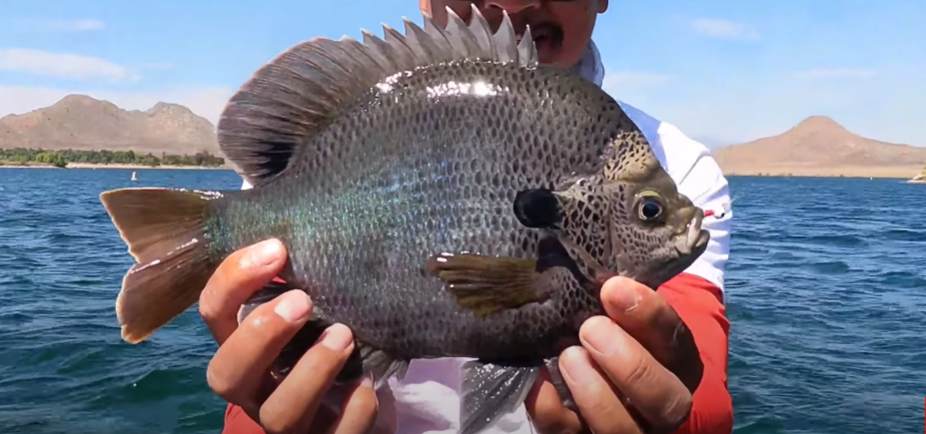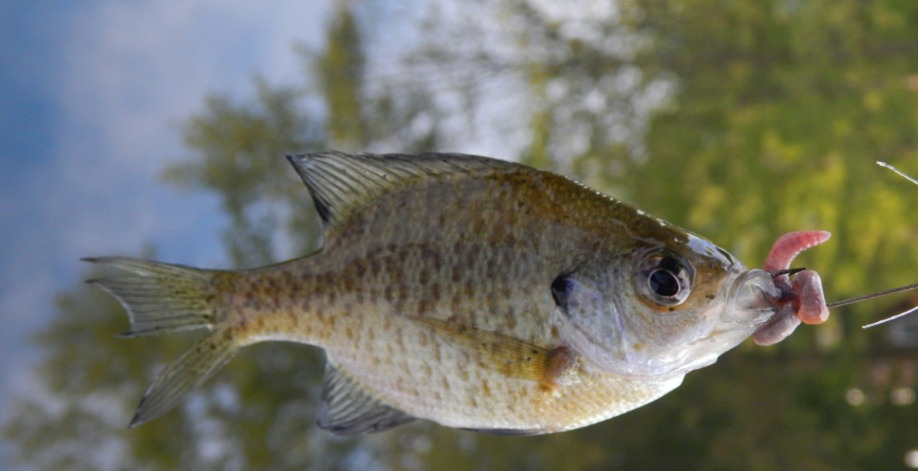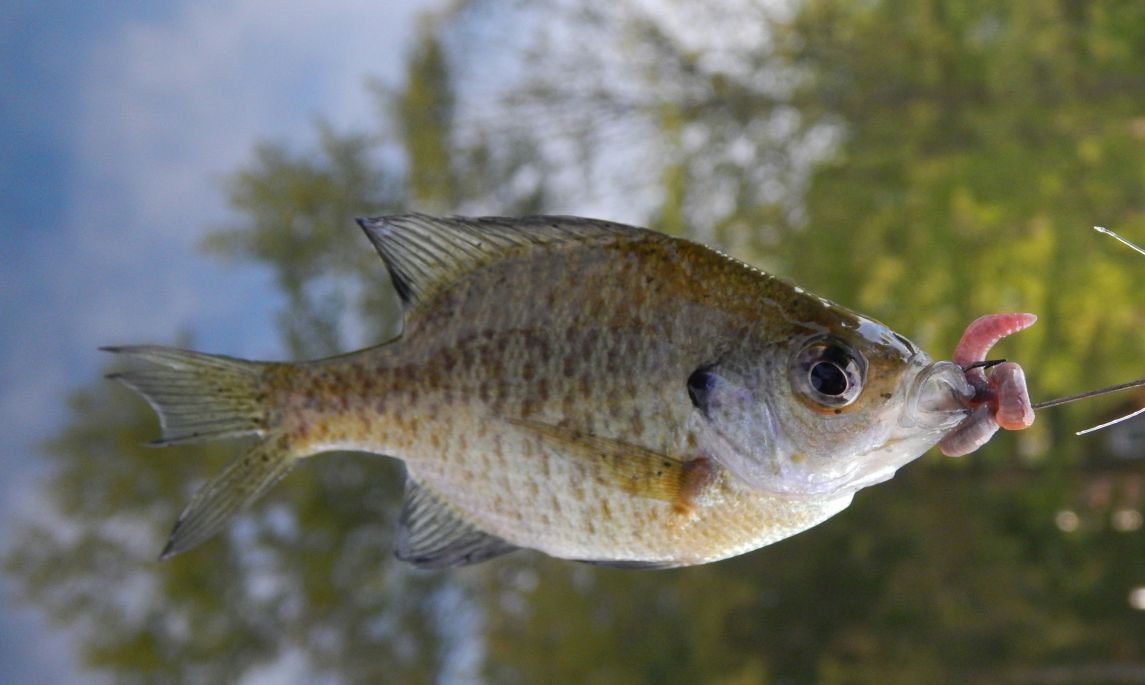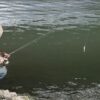Tired of the same old bluegill in your pond? Looking for a faster-growing, harder-fighting fish that can add excitement to your pond and dinner plate? Then look no further than the coppernose bluegill!
This vibrant subspecies of the common bluegill boasts a unique appearance, impressive growth rates, and a delicious taste.
This guide will tell everything about coppernose bluegill, exploring its traits, fascinating facts, and its potential as a pond superstar. We’ll answer your questions on appearance, diet, growth, and fishing.
What Is A Coppernose Bluegill?

The coppernose bluegill is a bigger variant or morph of the common bluegill species mainly found in Florida and the southeastern part of Georgia. It’s not a hybrid but has some distinct characteristics that set it apart from its cousin.
The most apparent distinction is the band stretching around the head of the fish, especially thick in male specimens. They also bear vertical bars and find a tinge of yellow and pencil white line at the borders of the fins.
Coppernose bluegill are larger and prefer to consume pellet feed than the common bluegill. If proper management and stocking are done, they can grow over the recommended size of 2 pounds.
Coppernose bluegills are faster in growth rate as well as in accepting the feed in the form of pellets than the common bluegills which makes them ideal for stocking in ponds for fisheries purposes.
Characteristics Of Coppernose Bluegill
Here’s a detailed breakdown of its characteristics:
1. Appearance
Low and of great breadth in the anterior part, flaring laterally, and with the dorsal outline convex. They are brown and copper with orange or green on the lower half of their bodies and are white with a reddish-orange to yellow belly. A broad-band zone that is copper or cream-colored and stretches across the nose to the gill cover.
This band is specifically more noticeable in spawning males. It also features thin, bright yellow or white margins along its fins. On average, they are larger than the common bluegills in size. Adults are generally a little larger in that they grow up to rise to 10 inches in size as well as 2 pounds in weight under proper circumstances.
2. Habitat
The coppernose bluegill is endemic to the freshwater bodies of water including lakes, ponds, and rivers in the central and southern part of Florida as well as in a section of southeast Georgia. They like water temperatures above 75 F and clear waters with lots of plants for shade.
3. Diet
Generalist, the diet of this water fish consists of many types of water insects and their larvae, plankton, small worms as well as, occasionally minnows. It feeds while opportunities last especially during breaks in the night such as early morning and late evening.
4. Breeding
The spawning of this fish takes place in spring and early summer; the water temperatures are between 68-75°F. Males turn into persona and build nests in shallow waters where the bed of the water is sandy or gravel. Females lay eggs in the nest and they are fertilized and incubated by the male till the eggs hatch.
5. Subtypes
Coppernose Bluegill is a subspecies and is not a hybrid. As far as the subclasses are concerned, there is nothing of this kind, but there are differences that can be observed regarding the coloration of the coppernose bluegills and those are caused by the water conditions, the diet, and the age of the fish.
Facts About Coppernose Bluegill
Do Coppernose Bluegill And Redear Sunfish Look Alike?
Yes, somewhat. Both are sunfish with compressed bodies and colorful markings. But copper noses have the copper band and lack the elongated ear flap typical of Redear sunfish.
How Big Do Coppernose Bluegill Get?
Larger than common bluegill! Adults can reach 10 inches, with some exceeding 2 pounds in ideal conditions.
How Long Do Coppernose Bluegill Live?
Lifespan is similar to common bluegill, around 4-6 years in the wild, with some reaching 11 years in healthy ponds.
How Fast Do Coppernose Bluegill Grow?
Faster than common bluegill! They readily eat pellets and can reach harvestable size within a year under good conditions.
Are Coppernose Bluegill Good To Eat?
Absolutely! They are popular panfish with a mild, sweet flavor.
Will Bluegill Take Over a Pond?
Yes, if unchecked. They reproduce prolifically. Balanced stocking with bass helps control bluegill populations.
Coppernose Bluegill Vs. Native Bluegill
Here’s an insight on key differences between coppernose bluegill and native bluegill.
Nose: Bluegill have a bluish-purple cast while coppernose have a copper or cream-colored stripe above the nostrils that is absent in native bluegill.
Body: The two fish share the 3-4 body concavity but coppernose seems to have a slightly deeper body depth.
Fins: According to differences, Coppernose has a yellow coloration of its fins in contrast to the colorless fins that are distinct from bluegill.
Size: Coppernose grows slightly larger than the Black mandarin, with its maximum size recorded as being 10 inches long and 2 pounds in weight, under the best natural habitats. Bluegill which are native usually do not grow very large and rarely exceed 8 inches and 1 pound in length.
Native Range: Coppernose are endemic to the smaller regions ranging from central and southern Florida and some corners of southeast Georgia. Wild bluegill is native only to the eastern part of the United States and the southern part of Canada but central has a broader range.
Water Temperature: Coppernose might be less winter tolerant than native bluegill.
Growth Rate: Coppernose grows larger than the native bluegill in general and they grow bigger especially when they are fed on pellets.
Diet: Although they eat the same type of foods, coppernose can easily adjust to dietary alterations such as being on a pellet diet.
Breeding: They spawn in spring/summer, but according to some investigations, coppernose spawn may have a slightly shorter period in comparison with the other.
Overall:
Coppernose are a variety of the common bluegill and, therefore, share a great similarity with the common bluegill but with a few differences. They are particularly known in pond stocking because they tend to grow faster compared to the other fish species and can grow larger.
Unlike most other fish species, no official subtypes exist within coppernose bluegill, although color variations may be observed. As said, the two types of bluegill fish are not two genetically distinct species they can reproduce with each other.

Why Stock Coppernose Bluegill?
Yes, you can stock coppernose bluegill in ponds. Here are some advantages and disadvantages for doing so and then you can decide whether you like to stock the fish.
Pros of Stocking Coppernose Bluegill
- Faster Growth: Coppernose bluegill grows faster than native bluegill, reaching harvestable size within a year under good conditions.
- Larger Size: They have the potential to reach bigger sizes, exceeding 2 pounds compared to the 1-pound limit of native bluegill.
- Pellet Feeding: They readily adapt to pellet feeding, making them easier to manage and promote growth in ponds.
- Balanced Fishery: They provide a good forage fish for largemouth bass, helping to maintain a healthy predator-prey balance in your pond.
- Fun Fishing: Their aggressive feeding behavior makes them exciting to catch for anglers of all skill levels.
Cons of Stocking Coppernose Bluegill
- Overpopulation: Like native bluegill, they reproduce prolifically. Careful management with proper stocking rates and potential bass introduction is crucial to prevent overpopulation.
- Limited Range: They are not native to many areas. Check local regulations before stocking to avoid ecological imbalances.
- Cost: Coppernose bluegill may be more expensive to stock than native bluegill.
Stocking Rate of Coppernose Bluegill
The stocking rate for coppernose bluegill can vary depending on your pond’s specifics, but as a general guideline, it can be up to 1000 fish per acre of surface water. However, to ensure a healthy pond ecosystem, it’s crucial to consult with a fishery professional for an exact recommendation.
Tips For Fishing Coppernose Bluegill
When fishing for Coppernose bluegill, here are some tips that can enhance your fishing experience and increase your chances of success.
It is recommended to schedule your fishing trips during low-light periods when bluegill is most active. To attract them, consider using artificial flies, jigs, or worms that imitate their regular food sources. Choose sizes between 1/32 and 1/16 ounce for a more natural presentation.
To improve the chances of catching Coppernose bluegill, you should cast your bait near aquatic plants, logs, and other hiding spots where they prefer to hunt for food. Using light tackle can make the process of reeling in these fish even more thrilling due to their scrappy nature. Utilizing light spinning equipment and line is an excellent option when fishing for bluegill.
To capture their interest, it is suggested to consider using vibrant-colored lures that are easily visible in the water. Bluegill are inquisitive animals, and bright colors can catch their attention. Try out various colors to determine which ones are most effective at your fishing location.
Coppernose bluegill are known for being cautious and can present a challenge to catch. It requires patience and determination to fish them, and you will eventually be rewarded with the thrill of catching one of these energetic fish.
Key Takeaway:
- Coppernose bluegill are the most active feeders during these low-light periods.
- Mimic their natural prey with flies, jigs, or worms in sizes around 1/32 to 1/16 ounce.
- Cast around aquatic plants, logs, and other structures where they hide and ambush prey.
- Their scrappy nature makes light tackle more exciting for reeling them in.
- Attract their attention with brightly colored lures that stand out in the water.
- While wary, they can provide good sport when hooked.
Conclusion
Coppernose bluegill is another variety of the common bluegill species and is characterized by faster growth, larger size, and better taste. It’s best suited for pond stocking because it feeds exclusively on pellets and can surely put up a balance with the largemouth bass. While they resemble Redear sunfish species, they will not have copper bands on the forehead and must not have an elongated ear flap.
Familiar with aspects such as its diet, habitat, as well as recommendations for fishing, this peculiar member of the sunfish family is useful for enjoying the catch. Just a note, you should contact a fisheries specialist regarding correct stocking rates and rules for beneficial pond biology.



















Leave a reply